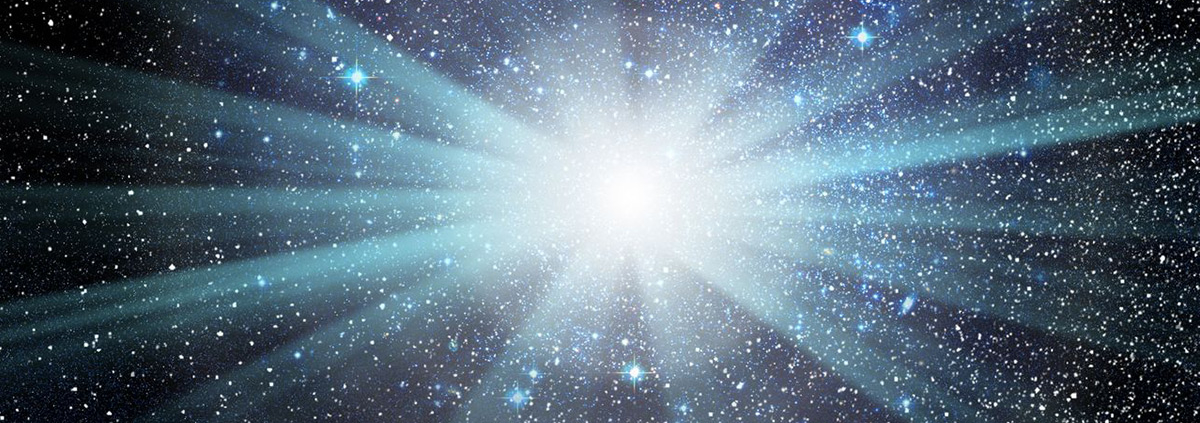#2 Beginning of the Universe
The Genesis account of the beginning of the universe was written down in the Hebrew Scriptures some 3,500 years ago. “In the beginning, God created the heavens and the earth.” Up until recently, however, the scientific consensus was that the universe was not created but was infinitely old. The Bible said that there was an eternal Creator and science said there was an eternal universe. They were at odds with one another, and no definitive reconciliation could be conceived. In the last 50 years, however, science has come to believe that the universe, space, and time had a beginning in a cosmic burst of energy some 13.8 billion years ago and has called it the “Big Bang.” The Big Bang confirms that the universe had a beginning, which corresponds to the Genesis account.
The Bible says “that” God created the heavens and earth, but it doesn’t say “how,” other than that he spoke it into existence. And it doesn’t say “when,” other than “in the beginning.” There are four major differing biblical interpretations as to specifically how and when, but they all agree that God did it.
In this session we will explore what the Big Bang theory has come to believe about the origin and destiny of the universe.
- It was given birth out of an infinitesimal dot of energy and matter of near infinite density and in tens of billions of degrees of heat and light.
- It has no known cause. In fact, science says it is impossible to discover what happened before the first trillionth of a trillionth of a second.
- Both space and time (space-time) were created at the Big Bang, and its expansion (inflation) has been accelerating at a fantastic rate ever since.
- The four fundamental forces of nature (behind the natural laws) were also created at that time.
- In less than the first minute, the universe was a million billion miles across with hydrogen being the only element.
- After the first minute, all the other known natural elements (92 of them) were created through the outworking of natural laws.
- Clumps of elements formed the stars and galaxies by natural processes. One of these stars became our Sun. These processes continue to this day.
- Gas and dust clouds surrounded our Sun and condensed to form our solar system of planets — one of which was planet Earth, born some 4.5 billion years ago.
Prior to 1965 the Big Bang theory was only moderately accepted. One reason it was resisted was because it sounded too much like the Genesis account, and that was “philosophically unacceptable” to some. Science had no desire to “accommodate religion,” and in some quarters was even hostile to it. But it couldn’t avoid the data — science found solid evidence consistent with an origin of the universe. Then even deeper questions were raised — how could something apparently come out of nothing? Astronomer Arno Penzias won the Nobel Prize for his role in this amazing discovery (1978) and became a religious believer at age 50, saying, “The best data we have are exactly what I would have predicted had I nothing to go on but the five books of Moses, the Psalms, and the Bible as a whole.”
This discovery story begins in Los Angeles in the 1920s at the Mt. Wilson Observatory and involves a most fascinating cast of characters: Edwin Hubble, a law student turned astronomer; Georges Lemaitre, a Belgian Catholic priest and astronomer, and Albert Einstein, who didn’t want to believe in an expanding universe. Einstein later called his take on that as the biggest blunder of his life. The story reaches an inescapable conclusion with Stephen Hawking helping to put the final nail in the coffin of an eternal universe by showing that time was also created at the moment of the Big Bang.
The universe is like a time machine. At its farthest edge we can observe the very first vestiges of the initial “explosion.” With our telescopes we are actually looking back in time to what existed 13.8 billion years ago — as well as everything in between that is closer in time and distance. In this session, we will tell the story of the development of the theory and the scientific evidence that supports it. We will take an amazing tour across the vast distances and of time and space, “watching” the birth and death of the galaxies, stars, and planets that adorn our skies. How far away are they? How big are they? How fast are they moving? Where are they going? What’s it like in outer space? What are these four forces of nature (behind the natural laws), and are they complete?
We will discuss the compatibility of the Big Bang theory with the biblical account. If God is the cause of creation, then who or what created God? Is the Big Bang a miracle? What are miracles, and how do they differ from natural events? Is it OK for scientists to believe in miracles, or are they restricted to think only in terms of natural events?
This will be an exciting tour of one of the most extraordinary mysteries of all time, and space!
RECOMMENDED READING FOR FURTHER STUDY
A Brief History of Time: From the Big Bang to Black Holes, Stephen W. Hawking, Bantam Books, 1988
Stephen Hawking's Universe, The Cosmos Explained, David Filkin, BasicBooks, 1997
The First Three Minutes: A Modern View of the Origin of the Universe, Steven Weinberg, Basic Books, 1993
A Universe From Nothing, Lawrence Krauss, Atria Books, 2013
The Fingerprint of God, Hugh Ross, Reasons to Believe, 2010
Why the Universe Is the Way It Is, Hugh Ross, Baker Books, 2008
In the Beginning Was Information, A Scientist Explains the Incredible Design in Nature, Werner Gitt, Master Books, 2006
Thinking God's Thoughts, Johannes Kepler and the Miracle of Cosmic Comprehensibility, Melissa Cain Travis, Roman Roads Press, 2022
God and Galileo, David Block and Kenneth Freeman, Crossway, 2019
The Big Picture, Sean Carroll, Dutton, 2017
Coming of Age in the Milky Way, Timothy Ferris, William Morrow and Co., 1988
Genesis and the Big Bang: The Discovery of Harmony Between Modern Science and the Bible, Gerald Schroeder, Free Press, 2009
Not a Chance: The Myth of Chance in Modern Science and Cosmology, R. C. Sproul, Baker Books, 1994
Skywatching, David H. Levy, Time-Life Books, 1994
The Beginning and the End of the Universe, Astronomy magazine, January 2021, www.Astronomy.com



